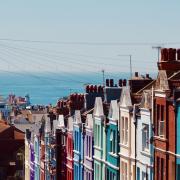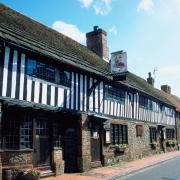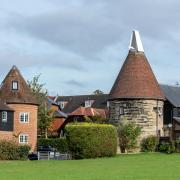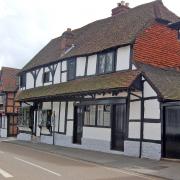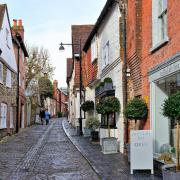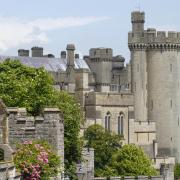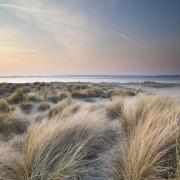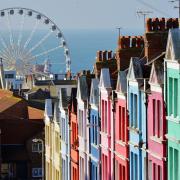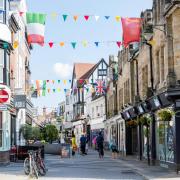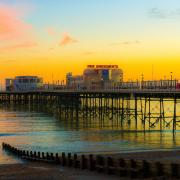Clive Agran’s monthly investigation of Sussex’s hidden past turns homeward as he visits Bodiam, Northiam and Ewhurst Green
Followers of this series will be familiar with the format. After the editor tells me which town is next, I seek out the individual
who knows most about the place and then try to persuade him or her to accompany me on a fact-finding stroll around the streets with no bigger incentive at my disposal than a half-pint of shandy when it’s over.
After nearly two years travelling from Battle to Bognor Regis and plenty of places in between, not only is the formula looking as durable as Desert Island Discs but I’m also acquiring so much information that, were I ever to be a contestant on Mastermind, I might drop Spurs, 1961-2001 as my specialist subject and substitute, Little-Known Facts About Sussex, 1066-2018. Then, possibly sensing complacency on my part, the editor hurls a wicked curve-ball in the shape of Bodiam and Nearby Villages before sloping off on maternity leaving me, if you’ll pardon the expression, holding the baby.
My first problem is geographical – which nearby villages? The second is even more serious – I can’t find an expert! Fearing reprisals from irate readers, I’m reluctant to reveal precisely where I live but – let me put it like this – Bodiam isn’t all that far away and since I’ve been living where I am for 25 years perhaps I know enough to manage this assignment on my own. After much agonising and with sincere apologies to residents of Robertsbridge, Hurst Green, Staplecross and Cripps Corner, I shall be focusing my attention on Northiam and Ewhurst Green as well, of course, on Bodiam.
Built towards the end of the 14th century, Bodiam Castle, with a drum tower at each corner and a wide moat, is everyone’s idea of what a castle should look like; that’s perhaps why it appears on so many calendars and the front cover of quality magazines! My very own detailed research reveals that last year it was the 147th most visited attraction in the UK.
Give or take a crumbling stone or two it looks, from the outside at least, very much as it did 600 or so years ago while the surrounding countryside has changed dramatically, especially in the last half-century. In 1946, no fewer than 1,183 acres in and around Bodiam was leased to Guinness. Hops were growing everywhere and an estimated 2,000 hop-pickers travelled down from London, alighted the train at Bodiam and enjoyed a cheap summer holiday gathering in the harvest.
By 1961 the acreage under hops had been reduced to 500 and by 1976 Guinness had gone. Nowadays, the hops have pretty well all disappeared as well and bines have given way to vines, especially on the south-facing slopes, as Bodiam makes a bid to become the new Bordeaux. This year’s scorching summer promises a bumper harvest and almost certainly a vintage crop.
Watching the slim Rother flow gently under pretty Bodiam Bridge (built in 1797), it’s hard to believe that a Viking fleet of 250 ships sailed this far up the river 1,100 years ago. In 1822 there was great excitement a couple of miles downstream in Newenden when the remarkably well-preserved remains of a very ancient ship were uncovered in a field. It was 65ft long and 14ft wide and, even more exciting, inside was a human skull with a pair of goat horns attached to the cranium. Sadly it transpired not to be Viking but a 14th century vessel of the type used for coastal trade. It might well have been delivering stone to the then under-construction Bodiam Castle.
Running more-or-less parallel with the river and also following the lie of the land is the Kent and East Sussex Railway line. Closed in 1961 but subsequently lovingly restored by an army of enthusiasts, the steam railway has been progressively edging its way further west from Tenterden since the first two miles were completed in 1974. It reached Northiam in 1990, Bodiam in 2000 and is now hoping to extend all the way to Robertsbridge.
Northiam has welcomed a number of famous visitors. It can claim two historic houses and one remarkably old tree. On her regal way to Rye on 11 August 1573, Queen Elizabeth I stopped to have lunch under an oak tree in the village and to change out of her green damask silk shoes. The tree, which some believe could be 1,000 years old, is still standing but looks rather dead. The shoes were left behind as a memento of her visit and were kept in a nearby Jacobean mansion called Brickwall until 1972 when the magnificent property, which was already functioning as a specialist school for dyslexic children, was donated to the Frewen Educational Trust. Now called Frewen College, it is believed to be the first such school in the country, possibly the world.
Not only royalty but also prime ministers have visited Northiam; four of them and all on the same day, 12 May, 1944. Winston Churchill, William McKenzie King (Canada), Field Marshall Jan Smuts (South Africa) and Sir Godfrey Huggins (Southern Rhodesia) inspected the Allied troops gathered there in preparation for D-Day. A pair of field gates and two plaques by a recreational field in the village commemorate the occasion.
Every year thousands of gardening enthusiasts make a pilgrimage to world-famous Great Dixter on the northern edge of the village. There’s a splendid, 15th century, timber-framed house that was remodelled by Edwin Lutyens in the early 20th century for Christopher Lloyd, who surrounded it with a breathtakingly beautiful garden.
Travelling west from Northiam through narrow country lanes we arrive at the exceptionally pretty village of Ewhurst Green. Crowned The Best Kept Village in All Sussex back in 1979, it has a Norman church (St James the Great) and many impressive houses.
One of them, Ewhurst Place, was rented by Scout founder Robert Baden-Powell and his wife Olave in April 1913. All three of their children were born in the house and the 1st Ewhurst Scout Troop was inaugurated on the lawn with Olave sworn in as lady scoutmaster.
The Baden-Powells’ landlord, a young lieutenant in the army by the name of Arthur Widdrington Herdman, had inherited the house from his uncle. Sadly, he was killed in the trenches on 25 October 1914. Before leaving to fight in World War I, he made a will in which he left a three-acre field that adjoined Ewhurst Place to the village: “To be used as a village recreation ground. Also 300 pounds which after deduction of the cost of fencing etc to be invested and used for the upkeep of the said field and for the provision of Christmas presents for the benefit of the children attending Ewhurst Green village school.” Although the school has gone, he would doubtless have been delighted to know that the field still in active use, and now has a smart new Arthur Herdman Pavilion which was opened on the centenary of his death.
Although it was offered to them, the Baden-Powells declined to purchase Ewhurst Place. “Even if we could have done (raised the capital), it was not as conveniently situated as we should have liked,” remarked Olave, for whom the rather tricky train journey from London was a significant negative.
In particular she didn’t like changing at Robertsbridge to the then Rother Valley Railway. “It was a funny little line,” she recalled. “One bought one’s ticket on the train. The conductor would move precariously along the outside of the coaches, even when the train was in motion.
One would be sitting in one’s seat when suddenly the carriage door would open, letting in a blast of wind and rain, and there was the conductor. After collecting our fares, he would climb out through door and proceed to the next compartment.”
If the Kent and East Sussex Railway are successful in their efforts to reach Robertsbridge, it will be interesting to see if they revive this slightly hazardous but entertaining practice.
More…
• We went to find out more on the history of Rottingdean - Contraband goods provided a valuable source of income for Rottingdean in years past, and a number of illustrious figures have made it their home since then as Clive Agran discovers




